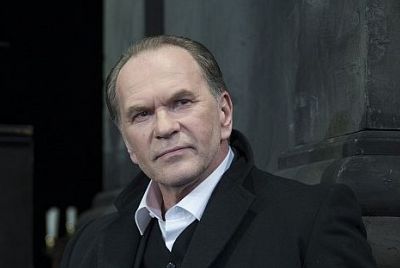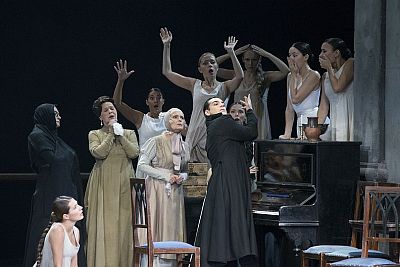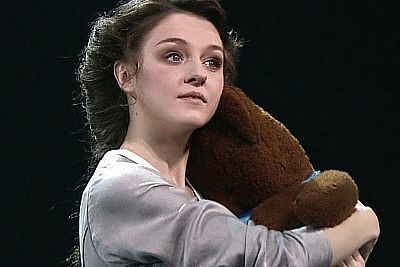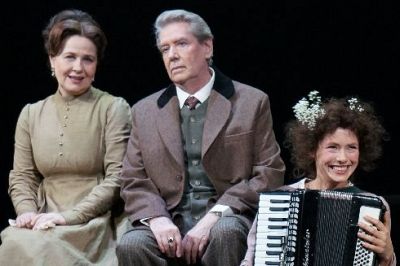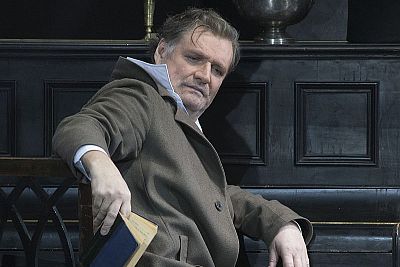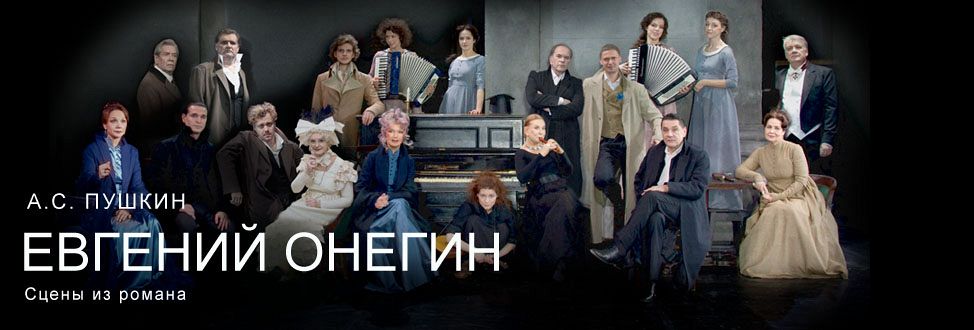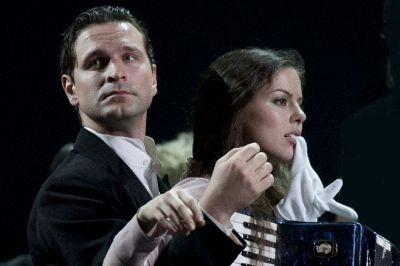| The idea, literary composition and staging | Rimas Tuminas |
| Set design | Adomas Jacovskis |
| Costumes | Mariya Danilova |
| Music | Faustas Latenas |
| Choreographer | Angelica Cholina |
| Musical director | Tatiana Agaeva |
| Lighting Designer | Maya Shavdatuashvili |
| Make-up artist | Olga Kalyavina |
| Work with actors | Alexei Kuznetsov |
| Scenic speech teacher | Susanna Serova |
| Editor | Elena Knyazeva |
| Eugene Onegin |
Sergey Makovetskiy, Aleksei Guskov, Victor Dobronravov, Eugeny Pilugin |


Rimas Tuminas in his production of “Eugene Onegin” does not aim at a full scenic adaptation of Pushkin’s novel in verse. For his main theme he chooses a story of Tatyana’s love for Onegin, a story with prologue and epilogue.
The performance unfolds in the memory and imagination of Pushkin’s characters. We are transferred from Onegin’s room into his country estate, then into the Larin’s house nearby, then to Moscow – and finally back to his room. The scale of events constantly changes: from noisy celebrations to secluded contemplation, from crowd scenes to lonely recollections, all of which are drawn together from the past just like the fragments of Tatyana’s love letter, framed and hung on the wall next to Onegin’s arm-chair.
The images in memory are split between past and present, between reality and imagination. Therefore, there are two Onegins on stage: the mature one recalling the events a quarter of century later and the second, younger one who takes part in them. There are two Lenskys on stage as well: the very young one as he was during the events, which led to his death in a duel and the second an imaginary white-haired companion of Onegin, the one whom Lensky could have become if he had not been killed. There is another character, not written by Pushkin but as if transported from the times of Pushkin's young years, from the golden age of the Russian culture – and aged just like Onegin. This is a retired hussar, dashing but crippled by war, intelligent but down-and-out, a drunkard reasoning about everything. He is granted the author’s voice and the right to intervene in the action in order to deliver “…reason’s icy intimations, and records of a heart in pain”.
“Eugene Onegin” was called “an encyclopedia of Russian life” in the XIX century: the scenes of everyday life, ideas, moods and habits of the Russian people in the capital and provinces are seen through Pushkin’s main storylines. Rimas Tuminas’ production also reaches out beyond the main plot. For instance, Tatiana’s name day celebration is enveloped in melancholy: it is Tatiana’s longing for her beloved as well as existential “Russian melancholy”, the subject of deep reflection for many poets and philosophers who perceived it as an expression of a sad, deeply nostalgic and purely Russian state of mind.
The horizons of the show are as wide as possible; the main plot is accompanied by the side storylines; and next to the main characters of “Eugene Onegin” there is a “chorus” created out of characters of the Pushkin epoch, the inhabitants of the capital, the countryside and even … the forest. During the exhausting journey to Moscow, a white hare crosses the path of the Larins’ carriage, either an apparition in the mind of the weary travelers or a real wild animal. To meet it on the road was considered a bad omen in Russia (just like a black cat nowadays). According to legend, a hare like this one ran across the road in front of Pushkin himself when he was going in a carriage to St Petersburg in December of 1825 to take part in the uprising against the tsar. Pushkin turned back, and by doing so avoided exile or even the death sentence. In memory of this event a road post was erected with the depiction of a hare on it and a sign reading “416 miles to the Senate Square”…
